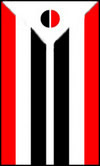Lesson Six - Part Three Transitive Verbs and Inanimate Objects
Since we've now started to name objects, we can begin to talk about transitive verbs - that is, verbs that involve one thing acting on another thing, or verbs which take an object. For example, in Arapaho you can say:
| I see the cup | |
| You are writing your name |
The forms for the personal pronouns are suffixed to the verb. Using nonoohoot- (see), the forms are:
| I see it | |
| You see it | |
| S/he sees it | |
| We see it [some say nonoohoot-owuni'] | |
| nonóóh-owu' | (same as above) [some say nonooh-owuni'] |
| We(incl) see it | |
| You(pl) see it | |
| nonoohóot-óu'u | They see it |
The -o- after the verb root can be thought of as "it," and the rest of the endings correspond to the different persons. Other examples are as follows:
| I have it. | |
| níit-ó' | He is afraid of it. |
| You are coming to it. | |
| You(pl) are coming to it. |
Note that these verbs are used only with inanimate objects. Here is a list of some very common TI verbs:
| he'in- | know it |
| nii3in- | have it (with you) |
| noohoot- | see it |
| wo3onoh- | write it |
| hotoonoot- | buy it |
| hitet- | get it, take it, get to it |
| to'oot- | hit it |
| cesin- | drop it |
| wo'ten- | pick it up |
Again, as we have seen before, these verbs can be used for questions and "no" responses, with the suffixes being replaced by prefixes. The system works almost exactly like it does for AI verbs, except that the special negative suffixes are different when more than one person is being talked about.
| I have struck it once. | |
| I have not (just) struck it. |
| You two have it. | |
| You(pl) don't have it. | |
| They don't have it. |
| You see it. | |
| Do you see it? | |
| koohe-noohóob-éébe | Do you(pl) see it? |
The full set of forms is:
| I don't see it | |
| You don't see it | |
| S/he doesn't see it | |
| We don't see it | |
| We(incl) don't see it | |
| You(pl) don't see it | |
| They don't see it |
| Do I see it? | |
| Do you see it? | |
| Does s/he see it? | |
| Do we see it? | |
| Do we(incl) see it? | |
| Do you(pl)see it? | |
| Do they see it? |

